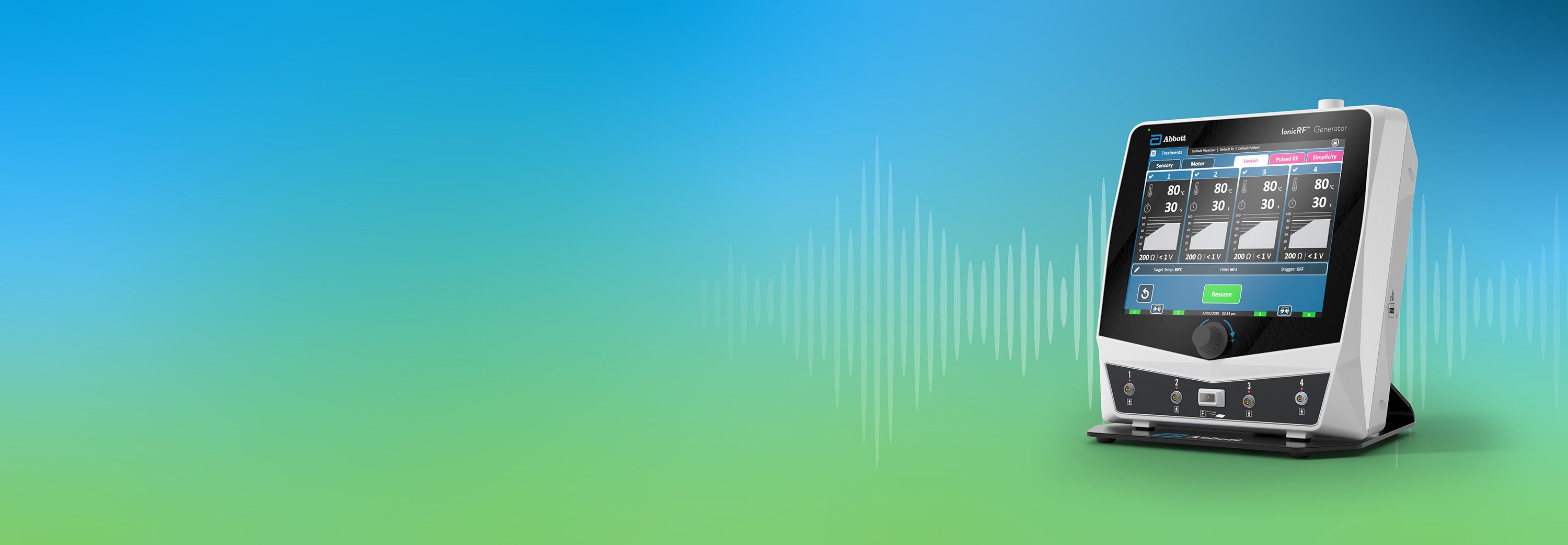IonicRF™ Generator
Prescription And Safety Information
Read this section to gather important prescription and safety information.
Intended Use
The IonicRF™ Generator, in combination with approved compatible electrodes and cannulae, is intended for lesioning of neural tissue in the peripheral nervous system as an aid in the management of pain.
Indications For Use
The IonicRF™ Generator, in combination with approved compatible electrodes and cannulae, is indicated as an aid in the management of pain in the nervous system. Examples include, but are not limited to, facet denervation, rhizotomy, and related functional neurosurgical procedures.
Contraindications
The use of this device is contraindicated in patients with systemic infection or local infection in the area of the procedure.
Warnings
The following warnings apply to this generator.
Instructions for use. Read and understand the instructions for use provided in this clinician's manual before operating the generator.
Hazardous electrical output. The generator is for use only by qualified medical personnel.
Electric shock hazard. This device presents an electric shock hazard under certain conditions. Physicians need to be aware of the following warnings:
- To avoid risk of electric shock, this equipment must only be connected to a supply mains with protective earth.
- Only approved medical grade power cords can be used with the generator. Use only the power cord specified for this unit. No modification of this equipment is allowed.
- Do not attempt to service or modify the equipment. For service, contact Abbott Medical.
- Do not under any circumstances perform testing or maintenance on the equipment while it is being used on a patient.
- Replace the power cord or plug immediately if it is cracked, frayed, broken, or otherwise damaged.
- Turn off the equipment and unplug the power cord before cleaning or servicing.
- Do not allow any fluid to enter the ventilation holes or sockets.
Equipment failure. A failure of the equipment could result in an unintended increase of output power. If unexpected parameters are observed that do not correspond to the preset values, halt the procedure immediately by pressing the Emergency Stop button on the top of the generator. Do not operate the equipment again until the source of the problem is identified and corrected.
Explosion hazard. Do not use this equipment in the presence of a flammable anesthetic mixture with air, oxygen, or nitrous oxide.
Fire hazard. This device presents a fire hazard under certain conditions. Physicians need to be aware of the following warnings:
- Do not use extension cords or adapters of any type. The power cord and plug must be intact and undamaged.
- Use recommended non-flammable agents for cleaning and disinfection whenever possible. See “Cleaning the Generator” (page 32).
- Flammable agents for cleaning, disinfecting, or as solvents of adhesives must be allowed to evaporate before using radiofrequency (RF) surgery.
- Do not place electrodes near or in contact with flammable materials.
Pooling hazard. Flammable solutions may pool under the patient or in body depressions, such as the umbilicus, and in body cavities, such as the vagina. Remove fluids pooled in body depressions and cavities before using the generator.
Ignition hazard. Be aware of and take care to avoid the danger of ignition of endogenous gasses (e.g., cotton and gauze saturated with oxygen may be ignited by sparks produced during normal use of the generator).
Risk of RF burns and unintended stimulation. Do not turn the generator power on while touching any electrodes or probes. Do not place a generator-connected electrode that is not being used in contact with the patient.
Risk of RF burns to patient. This device presents a risk of RF burns to the patient under certain conditions. Physicians need to be aware of the following warnings:
- Ensure the patient does not come into contact with metal parts of the table and its accessories. Antistatic sheeting is recommended.
- Avoid skin-to-skin contact between different parts of patient’s body (for example between the arms and the body of the patient). Use dry gauze if necessary.
- Avoid using physiological monitoring equipment during a procedure. If monitoring is required, place monitoring electrodes as far as possible from the electrode. Monitoring devices that use needle electrodes are not recommended. In all cases, monitoring systems with high-frequency current limiting devices are recommended.
- Connection of a patient to high-frequency surgical equipment and to electromyograph or evoked response equipment simultaneously may result in burns at the site of the electrodes and possible damage to the applied parts.
- Position all cables to the electrode and grounding pad (also known as the return electrode, dispersive electrode, or neutral electrode) to avoid contact with other electrodes and other metal objects.
- Place temporarily unused electrodes connected to the generator in a container or area that is electrically isolated from the patient. Never place a generator-connected electrode that is not being used in contact with the patient. When not in use, place accessories in a clean, dry, highly visible area away from patient contact.
- When not in use, place accessories in a clean, dry, highly visible area away from patient contact.
- Only use grounding pads listed in the Accessories section of this manual. See "Appendix C: System Components and Accessories" (page 42).
- When positioning the grounding pad, select a well-vascularized muscular site with proximity to the procedure. See "Applying the Grounding Pad" (page 20).
- Place the long side of the grounding pad perpendicular to the direction of the current flow from the operative site. See "Applying the Grounding Pad" (page 20).
- Do not place the grounding pad over scars, bony prominences, prostheses, hair, or EKG electrodes.
- Do not place the grounding pad in a location where fluids may pool.
- If the patient is sedated, place your hand on the backside of the grounding pad, while still leaving it attached to the patient. If the grounding pad is unreasonably hot (a temperature greater than 46°C), stop the procedure by pressing the Emergency Stop button.
- If the patient complains of heating at the grounding pad site, stop the procedure and remove the grounding pad from the patient.
- Before applying power to the electrodes, ensure that the entire area of the grounding pad is firmly adhered to a suitably prepared and appropriate area of the patient’s body as defined in the grounding pad instructions for use.
- If the continuity monitor alarm is triggered, remove and discard the grounding pad. Place a new grounding pad on a fresh patch of skin.
- If unexpected parameter readings are observed that do not correspond to the preset values, halt the procedure immediately by pressing the Emergency Stop button. Do not operate the equipment again until the source of the problem is identified and corrected.
- Connection of a patient to high-frequency surgical equipment and to electromyograph or evoked response equipment simultaneously may result in burns at the site of the electrodes and possible damage to the applied parts.
Interference with active implants. Check whether the patient has a cardiac pacemaker or other active implantable device and, if so, obtain qualified advice before using the generator. Operating the generator may interfere with or damage the implanted device.
Redirection of high-frequency currents. Check whether the patient has an electrically conductive implant and, if so, obtain qualified advice before using the generator. Operating the generator may cause concentration or redirection of high-frequency currents.
Interference with other equipment. During RF lesioning procedures, the radiated electrical fields may interfere with other electrical medical equipment. See "Minimizing Electromagnetic Interference" (page 5).
Shortwave or microwave equipment. Operation in close proximity to shortwave or microwave therapy equipment may produce instability in the applied parts.
Apparent low output or failure of equipment. If low output is observed or the equipment does not function correctly at normal operating setting, check the grounding pad and its connections.
Risk of patient injury. Do not use endoscopically. The accessories are not appropriate for endoscopic use.
Proper device use. Do not operate the generator if the alert tones are not audible after the volume is adjusted.
Non-sterile. The generator is non-sterile and should be kept outside of the sterile field.
Accessories. Use only accessories approved by Abbott Medical. See “Appendix C: System Components and Accessories” (page 42).
Continuity monitoring. The generator uses continuity monitoring. Loss of safe contact between the neutral electrode and the patient will result in an auditory alarm.
PRECAUTIONS
The following precautions apply to this generator.
Inspection. Inspect the generator and reusable accessories before each use. In particular, check the electrode cable insulation for possible damage.
Mechanical damage. If the equipment has suffered any mechanical damage, return it to the supplier for inspection and testing before further use.
Electrode positioning. Do not activate the generator output until the electrodes are correctly positioned in the patient.
Use of fluids. If fluids are being used during a procedure, ensure that they are positioned away from the generator.
Dispersive connections. Ensure that the grounding pad is connected to the patient and to the generator.
Cleaning the generator. When cleaning the outer casing or touchscreen, do not use abrasive agents or solvents. See "Cleaning the Generator" (page 32).
Emergency stop. For safety, always have someone positioned next to the Emergency Stop button during operation. If at any time the device is behaving erratically, press the Emergency Stop button, located on top of the generator, which will return the device to a safe state. For example, if the displayed temperature and graph do not match the desired set temperature.
ADVERSE EVENTS
Possible adverse events that may result from the use of this device include, but are not limited to, the following:
- As a consequence of electrosurgery, damage to surrounding tissue through iatrogenic injury can occur.
- Nerve injury, including thermal injury, or puncture of the spinal cord or nerve roots, potentially resulting in radiculopathy, paresis, and paralysis.
- Pain, pulmonary embolism, hemothorax or pneumothorax, infection, unintended puncture wound, including vascular puncture and dural tear, hemorrhage, and hematoma.
MAT-2300506 v1.0 | Item approved for EMEA use only.






Chronic Pain